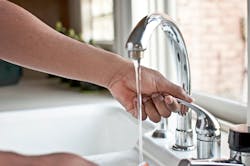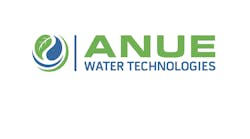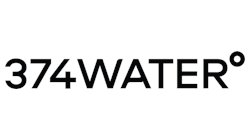Nitrates in concentrations above 10 parts per million (ppm) expressed as N (this can be expressed as 35.7 ppm as calcium carbonate or 44.3 ppm as nitrate) are considered unsafe in drinking water. Nitrates have no detectable taste or smell compared with ordinary substances in water, so nitrate removal processes must either be foolproof or include extensive monitoring of the treated water.
At levels which would not cause harm to adults, nitrates can cause methemoglobinemia, also known as "blue baby syndrome," in infants. The high nitrate levels interfere with the ability of the infant’s blood to carry oxygen.
Nitrate-selective vs. standard resins
Ion exchange resins have long been used for nitrate removal. Generally speaking, there are two kinds from which to choose: "nitrate-selective" and "standard." The major difference between them is the relative affinity of multivalent ions like sulfate and arsenate.
The relative affinity for some common ions found in drinking water for standard Type 1 and 2 resins is (from greater to lesser affinity): Perchlorate >> Sulfate > Arsenate > Nitrate > Chloride > Bicarbonate.
In contrast, nitrate-selective resins actually are de-selective for multivalent ions, like sulfate and arsenate. These resins have higher affinities for nitrates than all other common ions found in drinking water, including sulfates.
The relative order of affinity for some common ions found in drinking water for nitrate-selective resins is: Perchlorate >>> Nitrate > Sulfate > Arsenate > Chloride > Bicarbonate.
A fair number of nitrate-selective resins have been synthesized. The two types most widely used for potable water are tributylamine and triethylamine. Both are available with NSF certification for potable water.
Pretreatment
Nitrate removal systems usually only require pre-filtration and de-chlorination (if chlorine is present) as pre-treatment. These two steps are necessary to protect the anion bed from oxidation and physical fouling.
Softening ahead of the nitrate removal resin is not necessary, except in cases of high pH and high-hardness waters (4 grains or higher) where the concentration of carbonates and hydroxides in the resin bed could cause precipitation of calcium or magnesium. If this happens, a brief soak or rinse of the resin bed with a mild acid may be required.
Simple, effective
The ion exchange process for the removal of nitrates is both simple and effective. It operates in the same manner as a common water softener and can easily remove well over 90 percent of the nitrates. The process uses a strong-base anion exchange resin, which is regenerated with common salt (NaCl) or potassium chloride (KCl) (use 1.27 pounds of KCl to replace each pound of NaCl regenerant with virtually identical results). The chloride ion of the salt is utilized by the resin. The sodium ion passes right through the resin bed and does not affect the process.
The anion resins used in nitrate removal applications are typically regenerated with 10 to 15 pounds of salt (pure basis) per cubic foot — this is applied as a 4 percent to 8 percent solution concentration. Service flow rates are usually between 2 gallons per minute per cubic foot (gpm/ft.3) to 4 gpm/ft.3 for continuous flows, with peak flows up to about 10 gpm/ft.3. This is similar to typical softener flow rates. A minimum resin bed depth of 30 inches is recommended.
Some operating contrasts
In many respects, the operation of a nitrate removal unit is similar to an ordinary softener. But, there are differences, especially in regenerant concentrations, leakage and backwash characteristics:
- Anion resins are less dense and require a backwash flow rate about 1/3 that of softening resin.
- Since anion resins tend to float when salt concentrations rise above 10 percent, salt concentrations are typically applied at 4 percent to 8 percent.
- Regenerant levels must be high enough in nitrate removal to ensure that nitrate leakages are kept to acceptably low levels. In certain cases, extended rinses may be required after regeneration before nitrate levels reach acceptable levels. Techniques such as counter-current regeneration or re-mixing after regeneration can reduce and even eliminate high initial leakages.
‘Nitrate dumping’
The amount of a particular ion in potable water that a resin will hold varies directly with both its affinity and its relative concentration with respect to the other ions in the influent.
At the concentration levels in drinking water, sulfate has a higher affinity for the standard strong-base resins (Type 1 and Type 2) than nitrate. Nitrate is more strongly held than chloride and bicarbonate. If run past the point of exhaustion, these resins will continue to remove sulfate at the expense of nitrate, causing the nitrates to be "dumped" from the resin. When this happens, the concentration of nitrates in the effluent can approach the sum of the concentrations of both the sulfates and nitrates in the raw water.
For example, if water containing 80 ppm of nitrates and 85 ppm of sulfates is passed through a standard anion resin, the nitrate will leak before the sulfate. Effluent nitrate concentration will continue to rise until after the sulfate leakage begins. The ultimate nitrate level in the effluent will approach 165 ppm (sum of sulfate plus nitrate). When this happens, it is referred to as chromatographic peaking or simply "nitrate dumping."
Figure 1 shows the leakage behavior of various ions for a virgin Type 1 strong-base resin. Nitrate leakage peaks at a concentration greater than the influent, well before divalent ions such as sulfate and arsenate.
Figure 2 shows the leakage behavior of a nitrate-selective resin. Nitrate-selective resins prevent dumping in almost all potable waters. In some cases, such as high sulfate waters, they also can provide higher operating capacity, but their major advantage is increased safety by prevention of chromatographic dumping of nitrates.
Relative affinities
Generally speaking, nitrate-selective resins have from 10 times to 100 times higher relative affinities for nitrates against sulfates than the standard resins. Because of this, it is the sulfate ion that would be "dumped."
When a nitrate-selective resin is run past the point of exhaustion, the nitrate concentration of the treated water gradually will rise to its inlet concentration. The sulfate concentration in the effluent will rise above its inlet concentration.
There are different types of nitrate-selective resins and each has its own advantages, depending on the application. The triethlyamine structure, because of its smaller size, yields a resin with a higher operating capacity than the tributylamine type. However, the tributylamine may provide lower chemical operating costs in large systems when regenerant use is minimized through brine reclamation schemes.
pH effects and leakage
Anion resins used for nitrate removal are regenerated into the chloride form after each regeneration and initially remove all ions in exchange for chlorides — not only nitrates, but also sulfates and alkalinity. The removal of alkalinity causes a drop in pH in the treated water to less than 5 in the beginning of each service cycle.
Any nitrate left on the resin after regeneration is likely to appear in the treated water as leakage during the next service cycle. This holds true for both standard and selective resins. Nitrate leakage will be similar for both under identical regenerant dose levels.
Leakage patterns are similar in all waters. Nitrates initially start out at high levels and decrease throughout the service cycle as the leftover nitrate from the previous cycle leaves the resin bed in the form of leakage. As the run continues, the leakage decreases until the resin is exhausted and breakthrough occurs.
Scott Blumhof is an application specialist in the Technical Support Department of ResinTech, Inc., West Berlin, NJ. He has a B.S. in chemical engineering and a B.S. in biochemistry from Lehigh University. He can be reached by phone at 856-768-9600, ext. 136, or by email at [email protected].


